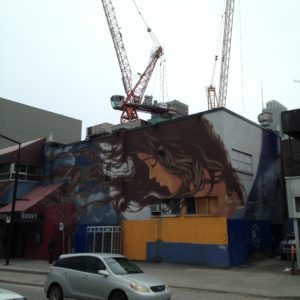I have been busy writing and disseminating my first thoughts on this project during the last few weeks.

Streetscene in Montreal, Canada
At the start of April I gave a series of talks on my current work on time and urban change at the Centre for Sensory Studies at Concordia University, Montreal, and at the City Region Studies Centre at Alberta University, Edmonton. I presented my work in progress, especially trying to work through how to link my sensory analysis of urban space together with a temporal one. The questions following my presentation have certainly helped me further my thinking, here are some of the ideas raised:
What is the speed of a urban regeneration project? Regeneration projects gain a momentum (funding), they accelerate but they also stop and pause, before maybe speeding up again or maybe be disposed. What are the forces behind the acceleration, stops and pauses?
Sensory experience is ephemeral, public life – street life – is transient and constantly changing, so what am I trying to do in my work? Am I trying to capture it? If so, am I not contradicting my own argumentation? Can I use photographs in my articles on time and urban change, because as soon as I use a photo I stop time – I capture the past. Do I need to highlight that these are ‘impressions’ and that the article is, following Simmel ‘impressionistic’. The article is like an Impressionist painting, trying to suggest but not finishing the brushstrokes.
The city changes so quickly that academia is always a step behind.
Most methodologies have a tendency to get at a snapshot of urban life and it is harder to get at methods that lend themselves to study longer durations.
What is the lived time of planning? I.e. what are the day to day tempos, deadlines, temporalities that planners experience in their day to day work?
How can the concept of timescape help us to resist regeneration?
